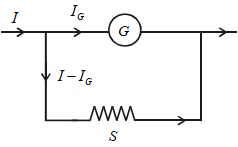Ammeter
A galvanometer can’t be used directly to measure big currents. To measure large currents, we have to carry out some modifications in the galvanometer. What we get after modifications is known as ammeter. An ammeter is a device for measuring the electric current through a wire or a circuit element.
The current is the flow of electrons whose unit is ampere. Hence the instrument which measures the flows of current in ampere is known as ampere meter (or) ammeter. The ideal ammeter has zero internal resistance, but practically the ammeter has small internal resistance. The measuring range of the ammeter depends on the value of resistance.
Suppose we want to make an ammeter that can measure current up to I. Such an ammeter is said to have a range of 0 – I. For this we have to connect a small resistance in parallel with the galvanometer as shown below.

The value of S is so selected that only IG current passes through the galvanometer and the remaining I – IG through the shunt. Let the resistance of the galvanometer be G. since G and S are in parallel, the potential difference across them should be same, i.e.,
\({{I}_{G}}G=S\left( I-{{I}_{G}} \right)\,\,\Rightarrow S=\frac{G{{I}_{G}}}{I-{{I}_{G}}}\).
The above equation gives the value of S to be connected in parallel with the galvanometer to convert it into an ammeter of range 0 – I.
An ammeter is used in series to measure the current. The reading of an ammeter is generally lesser than the actual current in the circuit. The lower the value of shunt resistance, the higher the range of ammeter.
